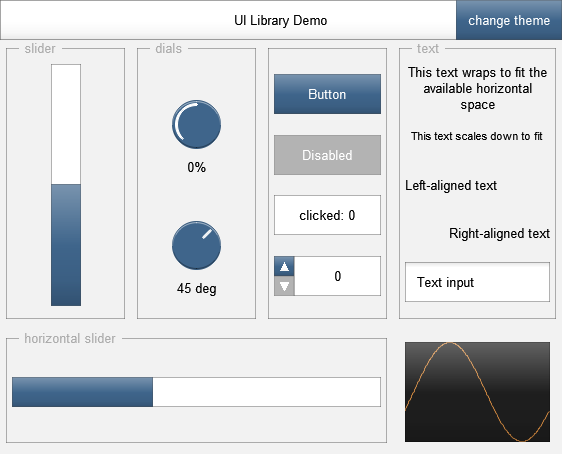jsfx-ui-lib
ui-lib.jsfx-inc: UIs for REAPER’s JS effects
This is a library/framework for creating UIs in REAPER’s JSFX language.
Download the latest version from GitHub, or the Stash ZIP which also includes API docs.
It requires REAPER v4.60 or above. See the Cockos forum topic for any questions/bugs/requests.
Features
- Flexible layouts (adapts to available space)
- Rich built-in controls
- buttons
- sliders
- dials
- selectors
- text-input boxes
- Multiple screens (including argument-passing)
- Themes (default, black, tron)

API
The best way to get started is the quick-start tour, which explains some principles of how the library works. After that, hopefully the API docs will make sense.
The full API is available as HTML or as an interactive JSFX plugin.
Compatibilty
The file ui-lib-compat.jsfx-inc bridges the gap between the current API and previous versions.
If you update your version of the UI library and it complains about missing functions, include this file as well.
Generator Tool
There is an experimental web-based tool to generate UI code based on JSFX slider definitions. It’s not the tidiest code in the world, and it’s definitely not a full-featured UI editor, but it can handle some basic layouts.
Development
Development happens in “ui-lib.txt”, and the actual library is generated using a JSFX preprocessor.
This means that to assemble the final code, you’ll need Node.js installed.
node build.js
# or
npm run build
To monitor with nodemon, use npm run nodemon - you can also specify any additional locations to write the result to (e.g. the JSFX collection):
npm run nodemon -- ../my-jsfx-set/ui-lib.jsfx-inc
Tips and tricks
Automation, saving state, and “hidden sliders”
You can hide REAPER’s default slider by preceding the name with “-“:
slider1:0<0,1,0>-Slider Name
Hidden sliders are still automatable and their state is saved automatically.
Remember to save the state for
@gfx
[...]
my_control_value = control_dial(my_control_value, 0, 1, 0);
[...]
@serialize
file_var(0, my_control_value); // Works for both read/write
Versioning and complex effects
This is not specific to this UI library, but it’s a useful trick when developing complex effects.
In @serialize, the very first thing you should do is read/write a version indicator.
@serialize
preset_version = 1.01;
file_var(0, preset_version);
If you make significant changes, bump up this version. What this means is that you can detect when you’re loading a preset from an earlier version of your effect, and can perform some appropriate action.
@serialize
preset_version = 1.01;
file_var(0, preset_version);
preset_version < 1.0 ? (
// Didn't exist in older versions, use default
saved_value = 5;
) : (
file_var(0, saved_value);
);
If you do this right at the start of developing your effect, you can keep your effect backwards-compatible.